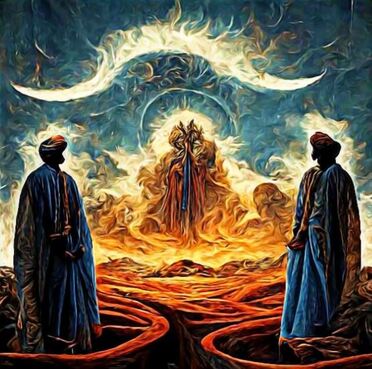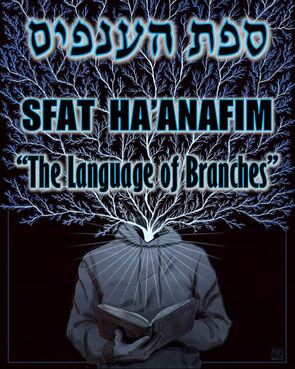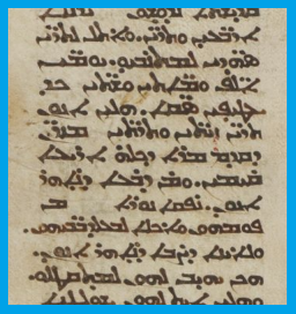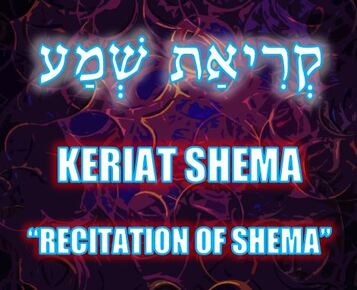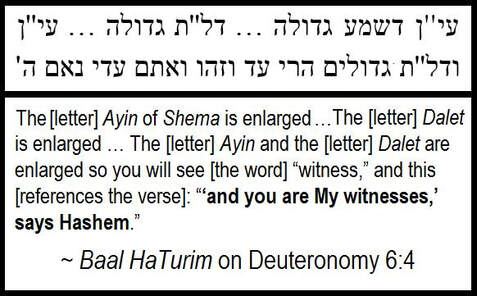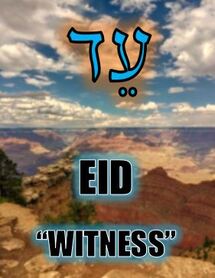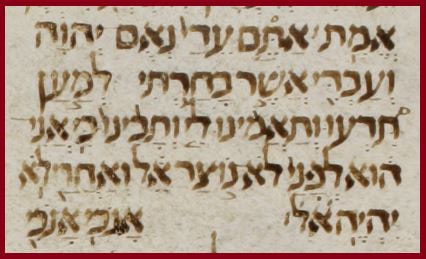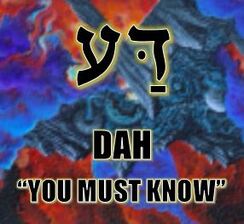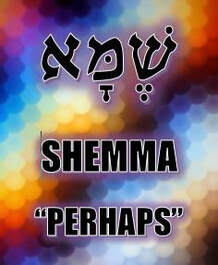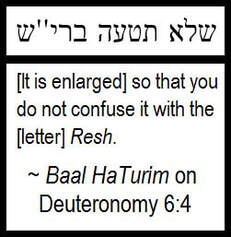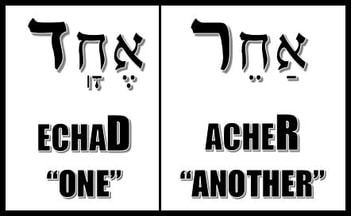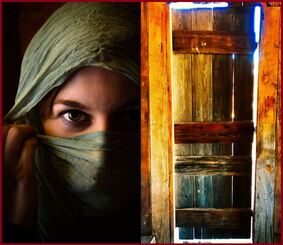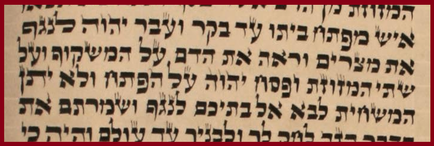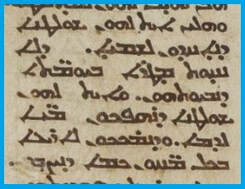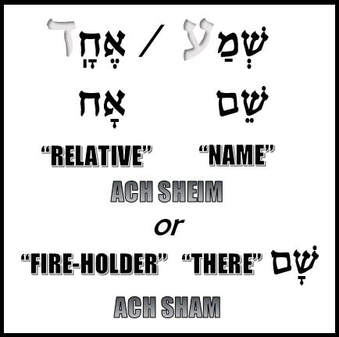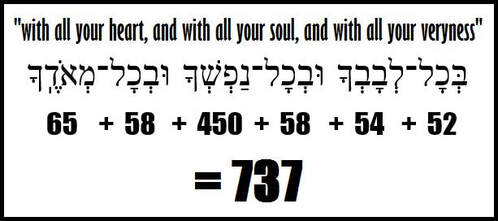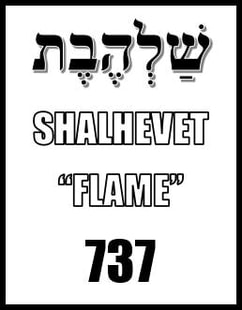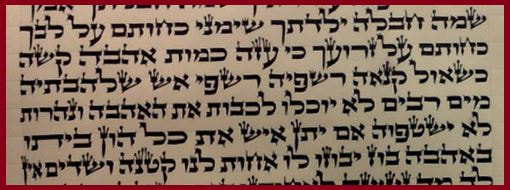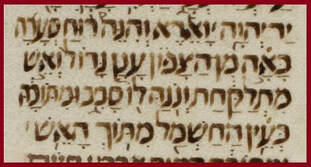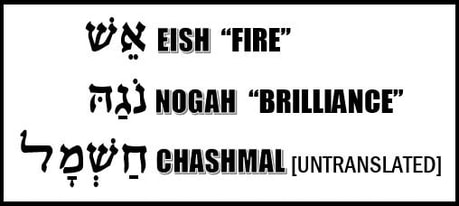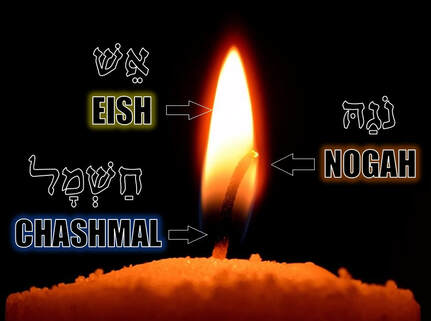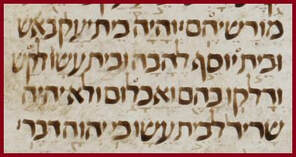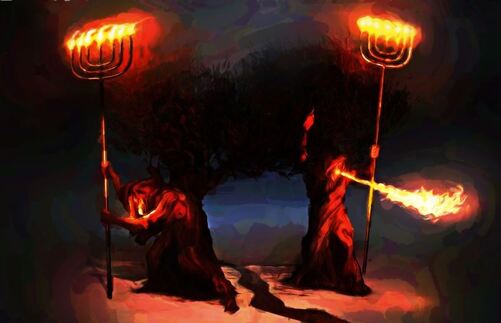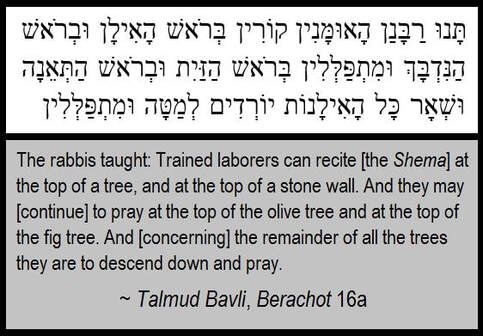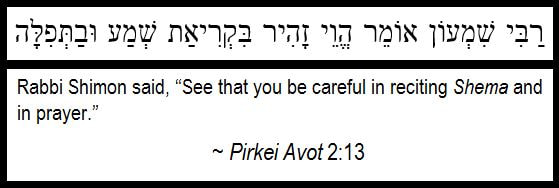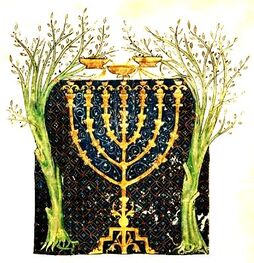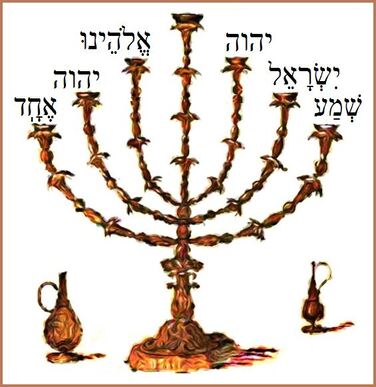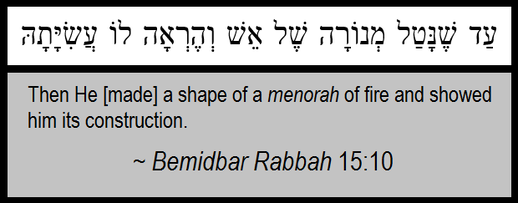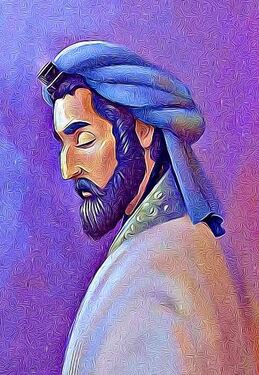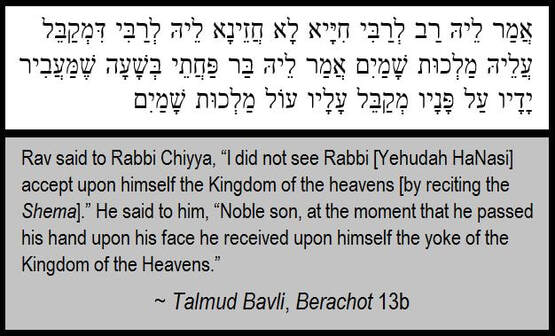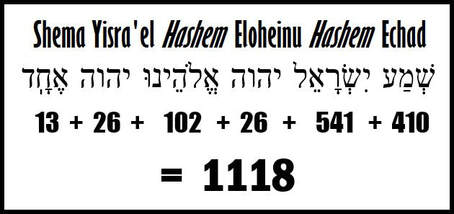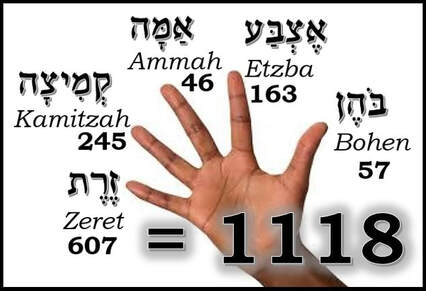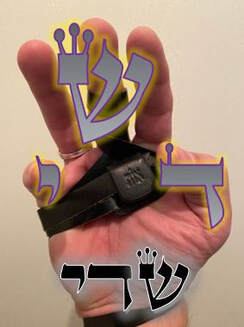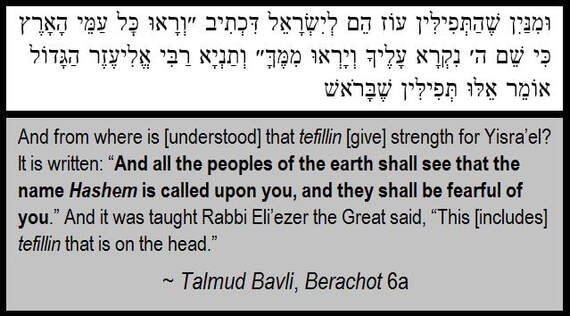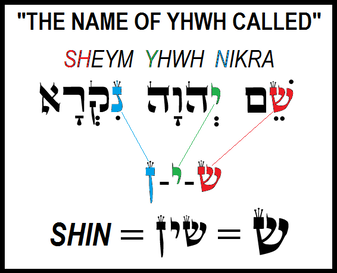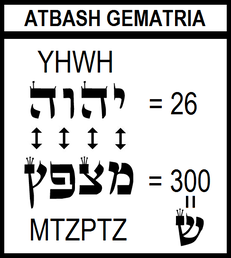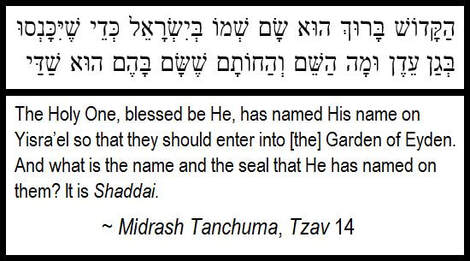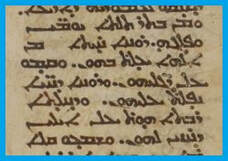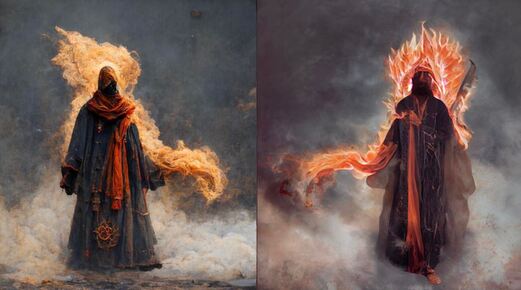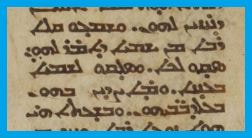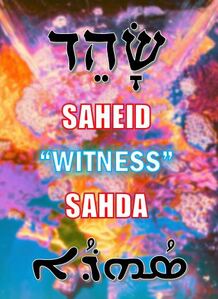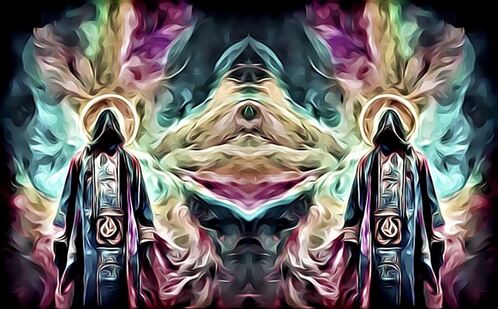THE TWO WITNESSES
by Jeremy Chance Springfield
3/1/2023
This study is also available in audio.
At the end of the New Testament sits the enigmatic book of Revelation, a text unique among its companions in its reliance upon references to the Hebrew Scriptures. With foundations rooted in the rich soil of Biblical text and traditional Jewish religious interpretations, it is easily the most complex and layered of the New Testament books.
The reason is that while its stated purpose is to reveal secrets, those matters are yet presented in information veiled with coded symbolism. Words and phrases in the book of Revelation often have a meaning different than what they would if encountered elsewhere. Written to be perceived by the spiritually discerning alone, the key to penetrating the mists of its emblematic language is in remembering it is a spiritual Jewish work steeped in Hebraic religious thoughts and utilizing those conceptual values preserved within the schema of Judaism.
It exists within this Semitic shroud, a complex cloak of words woven with threads spun in theological idioms that find context within the boundaries of Judaism. Due to this nature, a strictly literal approach brings only confusion at best and exegetical disaster at worst. Proof of Revelation's impenetrability is seen in its many maintained mysterious meanings.
The reason is that while its stated purpose is to reveal secrets, those matters are yet presented in information veiled with coded symbolism. Words and phrases in the book of Revelation often have a meaning different than what they would if encountered elsewhere. Written to be perceived by the spiritually discerning alone, the key to penetrating the mists of its emblematic language is in remembering it is a spiritual Jewish work steeped in Hebraic religious thoughts and utilizing those conceptual values preserved within the schema of Judaism.
It exists within this Semitic shroud, a complex cloak of words woven with threads spun in theological idioms that find context within the boundaries of Judaism. Due to this nature, a strictly literal approach brings only confusion at best and exegetical disaster at worst. Proof of Revelation's impenetrability is seen in its many maintained mysterious meanings.
|
Even its seemingly most obvious of imagery is far more intricate in intent than a cursory glance might otherwise suggest. A perfect example is that of the “two witnesses” of Revelation 11. Presented in the text as prophets, the dramatic symbolism enwrapping their account has Hebraic meanings running deeper than is often explored in normal treatments of their appearance. This study will show how expansive is their interpretation when viewed within a Jewish context. It is vital to recall the matter of the two witnesses is founded upon the Torah-based meaning of the Hebraic symbols.
|
The Bible cannot be read as any other book is read. Only applying reading comprehension skills learned from a mere secular education will fail to provide sufficient tools for understanding the Word’s spiritually rich content. Far be it from us to approach the text written by the Spirit with the frail limitations of the flesh. The original words, grammar, spelling anomalies, and even appearance of the text all impact what the Holy One intended for us to grasp when we read Scripture. It is a fractal of endless iterations, branching into untold faith-filled applications. No set rule exists to tell us how to read the Word. No boundaries are in place when dealing with the work of the Spirit.
|
The Hebrew phrase "Sfat HaAnafim" – “The language of Branches” – describes the Biblical text's supernal nature: it is more than its meaning. The Maker's immeasurable mind is distilled into phonetic vessels holding eternity in each term, bursting with a meaning far beyond normal expectation. To grasp the Spirit behind the script, believers must read with spiritual eyes to comprehend the text's coded symbolism, not thinking for a moment the message extends only to the Book’s borders and no further. Surpassing human comprehension, it is infused with infinite importance and should be read with His Spirit guiding us to the truths inherent in Himself, illuminating all the subtle nuances of eternal merit that await to be discovered.
|
The glory of interacting with inspired text is that the reader seeks the mind of its infinite Author, and so all manner of connotations can be uncovered if the Hebraic concepts provide the proper boundaries for meaningful exploration. Revelation’s portrait of the two witnesses is painted with this type of coded symbolism and imagery that are directly connected to the Hebrew Scriptures.
The passage of immediate interest is Revelation 11:3-5.
The passage of immediate interest is Revelation 11:3-5.
|
3 “And I shall give to My two witnesses, and they shall prophesy a thousand, and two hundred, and sixty days, while draped [with] sackcloth.
4 These are the two olive-trees, and the two menorahs who, before the Master of all the earth, are standing. 5 And he who seeks that he should harm them, fire goes out from their mouths and consumes their enemies. And those who desire to harm them, thus it is given to them to be killed. |
The identity of these two witnesses is honestly unclear. It is even uncertain that they are truly individuals, as the symbolism could be equally fulfilled in the form of groups or assemblies—a possibility supported by the assessments included in the letters to the seven assemblies (or menorahs "lampstands") earlier in the book.
Whomever they are and whether they refer to individuals or a collective group are peripheral questions, however. Far more vital is it to first note that they are called witnesses because they offer a witness or testimony of the true Creator in a world wrecked by idolatry. The foundation for their witness helps us to appreciate the information preserved about them here in Revelation 11. Therefore, let us first focus on the matter and its significance within the spectrum of a Torah-based mindset.
That foundation in the Torah is particularly in the greatest commandment we are called to fulfill: Deuteronomy 6:4.
Whomever they are and whether they refer to individuals or a collective group are peripheral questions, however. Far more vital is it to first note that they are called witnesses because they offer a witness or testimony of the true Creator in a world wrecked by idolatry. The foundation for their witness helps us to appreciate the information preserved about them here in Revelation 11. Therefore, let us first focus on the matter and its significance within the spectrum of a Torah-based mindset.
That foundation in the Torah is particularly in the greatest commandment we are called to fulfill: Deuteronomy 6:4.
This commandment is known popularly as the Shema, based on the pronunciation of the first word of the verse. Due to the wording of Deuteronomy 6:7, where we are told in the Hebrew text: VEDIBARTA BAM “and you shall speak them,” it is understood to be a commandment to audibly recite them every day. This practice is known in Hebrew as Keriat Shema “recitation of Shema.”
The theological weight of this passage has been recognized for millennia and attempted to be mined for all its spiritual value. While the English text may not immediately reveal its connection to the two witnesses of Revelation 11, the reality is the Hebrew behind the veil of translation is a treasure trove of spiritually significant information.
An assessment of the Hebrew letters comprising this statement shows that the scroll is written with the presence of textual oddities: in the flow of the ancient script are encountered two unusually enlarged letters. Under normal writing conditions, the Hebrew language does not use capital letters. Typically, any flow of Hebrew script will be presented with letters of essentially identical size.
In the case of the Shema, however, two letters are written in an unmistakably enlarged manner as they appear at the end of their respective words. This magnified form is known academically as a majuscule. They are the Hebrew letters Ayin in the term Shema, which is the first word of Deuteronomy 6:4, and Dalet in the term Echad, which is the last word of the verse.
The image included shows the majuscule letters as they appear in a Torah scroll where I have emphasized them with red.
An assessment of the Hebrew letters comprising this statement shows that the scroll is written with the presence of textual oddities: in the flow of the ancient script are encountered two unusually enlarged letters. Under normal writing conditions, the Hebrew language does not use capital letters. Typically, any flow of Hebrew script will be presented with letters of essentially identical size.
In the case of the Shema, however, two letters are written in an unmistakably enlarged manner as they appear at the end of their respective words. This magnified form is known academically as a majuscule. They are the Hebrew letters Ayin in the term Shema, which is the first word of Deuteronomy 6:4, and Dalet in the term Echad, which is the last word of the verse.
The image included shows the majuscule letters as they appear in a Torah scroll where I have emphasized them with red.
What is the purpose of these two oversized letters in an otherwise uniform flow of script? The answer is beautifully multifaceted and helps us to appreciate the imagery of Revelation 11 in important ways.
The Medieval rabbi, Ya’akov ben Asher, explained in his important work Baal HaTurim, in a commentary on Deuteronomy 6:4, that this unique script feature of the Torah’s text is spiritually meaningful.
The Medieval rabbi, Ya’akov ben Asher, explained in his important work Baal HaTurim, in a commentary on Deuteronomy 6:4, that this unique script feature of the Torah’s text is spiritually meaningful.
He asserts that the majuscule letters are infused with a higher meaning in themselves, performing a purpose above and beyond their presence in the words in which they are included. The two enlarged letters, therefore, if read together as if they were intended to form their own word, create the Hebrew term Eid “Witness.”
In the clear text of the Shema, then, are two “witnesses” that speak to the supremacy of the Creator and His sole right to our worship! By our faith-filled pronouncement of the Shema, we unite those letters and confirm our fealty to the will of the Maker of heaven and earth. In the passage quoted from Baal HaTurim above, Rabbi Ya’akov ben Asher validated his unique understanding of the two letters as implying the word Eid “witness” by referencing a partial quote from Isaiah 43:10.
The term “You” is ATEM here in the Hebrew, being the plural form of the word. For this reason, the two witnesses of Revelation 11 could themselves be two individuals or perhaps even two assemblies, as hinted at previously in this study as being a point of uncertainty. That ambiguity exists based on the grammar of the Hebrew text of Scripture.
Additionally, the above verse goes on to explain that our witness and servanthood to the Creator is to “know” Him in a meaningful way, one that places our trust in Him and no other spiritual entity. This declaration of “knowing” Him in conjunction with the claim that we are His “witness” finds a link back to the Shema also in another way.
If the two enlarged letters are read backwards, from left-to-right, the result is yet another term in Hebrew: DAH, meaning “know” in the imperative sense: “you must know.”
Additionally, the above verse goes on to explain that our witness and servanthood to the Creator is to “know” Him in a meaningful way, one that places our trust in Him and no other spiritual entity. This declaration of “knowing” Him in conjunction with the claim that we are His “witness” finds a link back to the Shema also in another way.
If the two enlarged letters are read backwards, from left-to-right, the result is yet another term in Hebrew: DAH, meaning “know” in the imperative sense: “you must know.”
An additional way to appreciate the oversized letters is to view them as emphasizing the correct pronunciation of the word that is in the text, so that no confusion occurs when it is read. If the two letters were to be unfortunately misread, the potential statement created would be a declaration of blasphemy.
The large letter Ayin ensures it is pronounced SHEMA “Hear / listen,” and not SHEMMA (with an Alef instead), which would, God forbid, yield the meaning of “maybe” or “perhaps.” A statement of doubt or uncertainty as to the validity of who is the Creator would thus be made.
The large letter Ayin ensures it is pronounced SHEMA “Hear / listen,” and not SHEMMA (with an Alef instead), which would, God forbid, yield the meaning of “maybe” or “perhaps.” A statement of doubt or uncertainty as to the validity of who is the Creator would thus be made.
Furthermore, the same text of Baal HaTurim quoted above also suggests the enlarged letter Dalet stresses a similar vital distinction:
In this situation, the large Hebrew letter Dalet ensures the text’s word “one” is pronounced correctly as ECHAD, and not use the almost identically shaped Hebrew letter Resh, thereby creating the word ACHER “another.” This would, God forbid, form the expression that the Creator is merely “another” deity, and not the sole Source of all existence.
When viewed from this perspective, the majuscule letters are significant guideposts leading the reader in the proper declaration of the most important statement of faith a human could ever utter. This is because man is not meant for idolatry. We are created in the Creator’s image to bring honor and glory to Him alone. Although man fell into the bondage of idolatry, He called us out of that pit and purchased us from the nations to be a people for Him who would begin the process of restoration for the entire world.
This truth of our purpose as witnesses and His desire for a people dedicated to Him can be perceived also by another perspective on these two enlarged letters.
This truth of our purpose as witnesses and His desire for a people dedicated to Him can be perceived also by another perspective on these two enlarged letters.
Incredibly, those two concepts of “sight” and “door” are paired in a passage that highlights our redemption from Egypt that came about by seeing the blood of the lamb upon the entries of the houses of the faithful enslaved in Egypt, as found in Exodus 12:23.
This “door” concept is furthermore linked to the Shema in that we are commanded in Deuteronomy 6:9 to write it upon our doorposts (and gates), much like the blood was to be applied at the first Passover.
Returning once more to the Baal HaTurim, an additional claim about the enlarged letter Dalet offers yet a further purpose of its presence:
Returning once more to the Baal HaTurim, an additional claim about the enlarged letter Dalet offers yet a further purpose of its presence:
The numerical value of the letter Dalet is 4, which explains the "four directions" mention. The detail about the heavens and the earth aligns with the nature of the two witnesses whose authority is manifested through miracles affecting both the heavens and the earth, as seen by jumping ahead momentarily in their description in Revelation 11:6.
It is certainly intriguing that the two witnesses of Revelation 11 are linked to the suggested purpose of the enlarged Dalet witness in the Shema with the same details of the “heavens” and the “earth.” As this study progresses, parallels such as this shall be a repeated feature.
However, before moving further on into the rest of the Shema’s content, one additional detail of the enlarged letters offers an important insight that serves also as a segue into the Shema’s next section.
The presence of the two enlarged Hebrew letter witnesses can also be viewed in a different manner. Since their size sets them apart from the rest of the text, and we have already seen they form unique terms if read together, then what happens if one were to read the two terms that they are originally a part of as if those two enlarged letters were not included?
The presence of the two enlarged Hebrew letter witnesses can also be viewed in a different manner. Since their size sets them apart from the rest of the text, and we have already seen they form unique terms if read together, then what happens if one were to read the two terms that they are originally a part of as if those two enlarged letters were not included?
When we recite the Shema with faith, it is a proclamation that we possess the authority of kin with the people of Israel, with the Holy One who has called Himself our Father. The Shema, then, in this sense, is the witness that we possess SHEIM ACH “the name of brother / kin.” By sincere expression of the truth held in the Shema, a believer professes his fealty to the Kingdom of Heaven—we are not a citizen only, but spiritual family who call upon the Creator Himself as kin!
Additionally, the secondary meaning of the two Hebrew terms if viewed without their majuscule letters yields the message of SHAM ACH “there [is a] fire-holder.” The recitation of the Shema acts as a “fire holder” to keep the flame of true faith burning through the centuries. Without the truth of the Creator’s identity and singular nature preserved in the words of the Shema, idolatry would abound in the uncertainty of who is responsible for this world and our worship.
With these amazing letter witnesses in place, it is now time to move forward into the rest of the Shema and see how the proclamation of faith in the one Creator is lived out in the life of such a witness. Returning now to Deuteronomy 6:5, the text tells us emphatically what this Shema life looks like.
Additionally, the secondary meaning of the two Hebrew terms if viewed without their majuscule letters yields the message of SHAM ACH “there [is a] fire-holder.” The recitation of the Shema acts as a “fire holder” to keep the flame of true faith burning through the centuries. Without the truth of the Creator’s identity and singular nature preserved in the words of the Shema, idolatry would abound in the uncertainty of who is responsible for this world and our worship.
With these amazing letter witnesses in place, it is now time to move forward into the rest of the Shema and see how the proclamation of faith in the one Creator is lived out in the life of such a witness. Returning now to Deuteronomy 6:5, the text tells us emphatically what this Shema life looks like.
The reality of knowing the Creator means we must react to the unfathomable kindness He has bestowed on creation. That response is love for Him that permeates throughout the very essence of our personal existence. This love encompasses all our heart, soul, and very essence. The Hebrew text is read as BEKOL LEVAVKA UVKOL NAFSHEKA UVKOL MEODEKA “with all your heart, and with all your soul, and with all your veryness.” This phrase holds a deeper significance in its numeric value that helps us to appreciate further what this love looks like. Since the Hebrew language is alpha-numeric, where each letter doubles as a number in a system known as gematria, the sum of this phrase from the Shema can be easily found: 737.
This sum of 737 for the way in which we are to love the Creator may not initially seem to be of any help, but it actually does direct us to a passage which clarifies how that love will look.
There is a Hebrew word whose gematria alone is also 737 — SHALHEVET “flame,” which only appears three times in all of Hebrew Scripture.
There is a Hebrew word whose gematria alone is also 737 — SHALHEVET “flame,” which only appears three times in all of Hebrew Scripture.
Of those three times, SHALHEVET is amazingly used once in the direct context of the topic of love, and not only that, but the nature of the love of the Creator! The passage is found in The Song of Songs 8:6-7.
|
6 You must set me as a seal upon your heart—as a seal upon your arm, for love is strong as death, intense as Sheol is jealousy—its spark [the] sparks of fire—the flame of Yah!
7 Many waters are not able to extinguish that love, and rivers neither shall overflow it. If a man should give the entire wealth of his home for love, it would be utterly despised [as an insufficient offer]. |
|
Love for the Creator must be as a fire that burns in us in an uninterrupted flame. This notion of an unextinguishable fire is based on the eternal flame commanded to be kindled on the altar, as seen in Leviticus 6:13.
This fiery nature of the believer’s love scorches every part of him. It is not to be dampened by anything but is to burn continuously as a witness to the eternal love we must possess for the Creator. Just as the believer is to experience this love in his heart, soul, and veryness, so too do we see that Scripture describes the spiritual flame of the Creator’s own glory in three fiery terms. This is seen in Ezekiel 1:4.
The three terms included in this text describing the spiritual aspect of the fiery glory are:
The last word I left in its phonetic transliteration due to extreme uncertainty concerning its true meaning. Suggestions vary from “amber,” to a “gemstone,” to even “electricity,” and also as a reference to a specific type of angelic entity. What can be gleaned, however, is that of the three basic aspects of a flame: the innermost, essentially invisible fire (CHASHMAL), the visible flame itself (EISH), and the glow / aura of that flame (NOGAH). Looking at a candle flame can easily explain these subtleties.
Remarkably, when one adds up the gematria values for all three terms describing the fiery nature of the Creator’s Presence, their combined sum is 737. This is the exact same sum as the term SHALHEVET “flame” used in the context of the Divine love, as seen previously in The Song of Songs 8:6, and it is the exact same sum of the Shema’s phrase of BEKOL LEVAVKA UVKOL NAFSHEKA UVKOL MEODEKA “with all your heart, and with all your soul, and with all your veryness!”
As a witness, that zealous love leaps forth to be shared with others. Those who receive it are similarly set ablaze to light the world, but those who reject it receive the fire of judgment from the witness’ own jealous love.
This detail returns us once again to the portrait of the two witnesses in Revelation 11:5, of whom the text declares fire comes forth from their mouths to consume their enemies.
This detail returns us once again to the portrait of the two witnesses in Revelation 11:5, of whom the text declares fire comes forth from their mouths to consume their enemies.
This piece of information, while unpleasant for all who would continue in sinful disobedience, is yet part of the love of the Creator, for love is meaningless if hate does not contrast it. And so the two witnesses of Revelation 11 use their burning love for the Creator to do what must be done to those who hate the Creator’s ways.
This concept of fiery judgment against His enemies by two faithful witnesses finds its origin in the words of Obadiah 1:18.
This concept of fiery judgment against His enemies by two faithful witnesses finds its origin in the words of Obadiah 1:18.
The prophecy foretold the severity of the judgment power of the two witnesses—from the people of Jacob and from the people of Joseph—that is to say, from both groups who ultimately comprise all of Israel. Their heavenly-sanctioned wrath will be poured out with devastating effect upon the people of Esau—that is to say, any workers of evil. The two witnesses of Revelation 11 are yet another portrait of the long-awaited vindication for those who embody a commitment to the Shema.
Returning to the passage from Revelation, it was seen quoted originally in this study in 11:4 that the two witnesses were referred to both as “olive trees” and as “menorahs”—that is, lampstands. The connection of this imagery to the Shema is once again present.
Returning to the passage from Revelation, it was seen quoted originally in this study in 11:4 that the two witnesses were referred to both as “olive trees” and as “menorahs”—that is, lampstands. The connection of this imagery to the Shema is once again present.
The first imagery of the two witnesses as olive trees is found in a quote from the Talmud Bavli, in tractate Berachot 16a, concerning the topic of saying prayers that include the Shema.
The purpose for preventing one performing Keriat Shema under most circumstances is due to the emphasis placed on the testimony of the verse. The reciter is declaring himself a witness to the Creator’s supremacy in all the earth. It must thus be done with solemnity and care. This is expressed in the ancient text of Pirkei Avot 2:13.
Trained laborers were given permission to pause their work where they were at if in certain trees (particularly the olive and fig), likely due to not being at great risk for falling out of them based on the presence of sufficiently sturdy branches. All others are required to descend in order to recite the prayers. Therefore, a person could absolutely be a witness for the Shema while up in the branches of an olive tree!
The second imagery of the two witnesses as menorahs in connection to the Shema is found in the number of words which make up the central declaration and the unique construction of the lampstand. There are six terms in the Hebrew of Deuteronomy 6:4, comprising the main recitation.
Although there are seven lamps attached to the six branches and the central shaft, the menorah’s construction is worded in the Hebrew with distinction between six branches and the shaft itself. This emphasis on the six branches aligns with a seamless parallel with the six words that make up the text of the Shema. This is seen in the wording of Exodus 25:32.
To this link is the traditional assertion of how the menorah’s construction was originally shown to Moses in a heavenly form, as recorded in the text of Bemidbar Rabbah 15:10.
The menorah was shown to him in a fiery form, further linking the Shema to the six branches with the concept of fire and the manner in which we are to love the Creator, as was previously shown in this study.
The remainder of the Shema’s content in Deuteronomy 6:7 is straightforward, with the command that we declare those words everywhere and to everyone—which is the underlying factor of being a witness as it is: testifying of His truth to anyone who will listen. What comes after, in Deuteronomy 6:8, is worth a closer look to see the incredible witness within it.
The remainder of the Shema’s content in Deuteronomy 6:7 is straightforward, with the command that we declare those words everywhere and to everyone—which is the underlying factor of being a witness as it is: testifying of His truth to anyone who will listen. What comes after, in Deuteronomy 6:8, is worth a closer look to see the incredible witness within it.
This link to the Shema is in the sign that we are told to make upon our hands. The “sign” and the “frontlets” are known together in Judaism by their name of tefillin, or as “phylacteries” when translated from the Greek text. Tefillin are to be worn all six days of the week, and while wearing them, one is expected to recite the Shema.
This is performed in a specific way. The Talmud Bavli, in tractate Berachot 13b, explains how one utters the Shema during daily prayer time.
This reference of accepting “the Kingdom of the heavens” is an idiom in Judaism for reciting the Shema. The Talmud reveals that the Shema is properly spoken by placing one’s hand upon the face and reciting it. The reason for doing this is entirely wrapped up in the command to make His Word (specifically the Shema, in this instance) a sign upon our hand. The reason can be found in the gematria sum for the Shema as stated in Deuteronomy 6:4.
The gematria for the sum of the Shema is 1118.
The gematria for the sum of the Shema is 1118.
This gematria sum for the Shema directly links to the hand of a person. This is seen by looking at the Hebrew words for the five fingers of the hand.
The Hebrew names for the fingers range from evidence in Biblical texts to post-biblical sources (such as the Talmud Bavli, Menachot 11a), but the use of such names is undoubtedly preserved from antiquity, as some cognate versions find attestation in other ancient Near East languages.
The Hebrew names for the fingers range from evidence in Biblical texts to post-biblical sources (such as the Talmud Bavli, Menachot 11a), but the use of such names is undoubtedly preserved from antiquity, as some cognate versions find attestation in other ancient Near East languages.
The total gematria for all five fingers of the hand is thus 1118—the exact same as the gematria for the Shema! Therefore, the connection of the hand to the Shema is also established in addition to the usage of tefillin for a “sign” upon it during reciting the verse.
Due to this incredible gematria parallel, the five fingers are utilized from a traditional act in the recitation of the first line of the Shema, incorporating the fingers of the hand as a physical sign language fulfillment of the Shema itself. To accomplish this, one covers the eyes with the fingers positioned in a specific form. The form is as such using the right hand while the eyes are closed: the thumb is bent and touches the right eyelid, and the little finger likewise touches the left eyelid. The remaining three fingers of the hand are extended towards the forehead. This form is intended to replicate a static “finger-spelling” of sorts, recreating the Divine name Shaddai in Hebrew, where the three extended fingers at the forehead make the letter Shin, the bent thumb makes the letter Dalet, and the little finger makes the letter Yud.
Due to this incredible gematria parallel, the five fingers are utilized from a traditional act in the recitation of the first line of the Shema, incorporating the fingers of the hand as a physical sign language fulfillment of the Shema itself. To accomplish this, one covers the eyes with the fingers positioned in a specific form. The form is as such using the right hand while the eyes are closed: the thumb is bent and touches the right eyelid, and the little finger likewise touches the left eyelid. The remaining three fingers of the hand are extended towards the forehead. This form is intended to replicate a static “finger-spelling” of sorts, recreating the Divine name Shaddai in Hebrew, where the three extended fingers at the forehead make the letter Shin, the bent thumb makes the letter Dalet, and the little finger makes the letter Yud.
Incredibly, the letters of Shaddai which the fingers form that touch the eyes are Yud = 10, and Dalet = 4 in their gematria values, making a sum of 14. These two letters form the spelling of the Hebrew word for “hand”--Yad! Additionally, when the two enlarged letters of the Shema are considered, it is recalled they are Ayin (meaning “eye”) and Dalet (meaning “door”), and the two fingers of the hand during the Shema rest upon the eyes, which are the “doors” to the mind.
Furthermore, this unique formation of the name Shaddai using all five fingers of the hand during recitation of the Shema finds a link also in that both tefillin and a mezuzah, in which are written the Shema texts, are found to include the Divine name Shaddai—formed creatively through the shape of the knots and winded straps of the tefillin, and written explicitly in Hebrew upon the back of the mezuzah parchment. Both links to the Shema in such usage also find additional connection in that the commandment of tefillin is explicitly linked to the hand and the fingers, and the mezuzah is commanded to be performed upon a dwelling’s doorpost, and the Hebrew term for “middle finger,” being AMMAH, also is used in Hebrew Scripture as an alternative term for “doorpost!”
The remaining three fingers of the hand that are set upon the forehead during the recitation of Shema are a further sign that represents the letter Shin. With this information, let us look now to Deuteronomy 28:10 for a curious detail provided there in the Hebrew text.
Furthermore, this unique formation of the name Shaddai using all five fingers of the hand during recitation of the Shema finds a link also in that both tefillin and a mezuzah, in which are written the Shema texts, are found to include the Divine name Shaddai—formed creatively through the shape of the knots and winded straps of the tefillin, and written explicitly in Hebrew upon the back of the mezuzah parchment. Both links to the Shema in such usage also find additional connection in that the commandment of tefillin is explicitly linked to the hand and the fingers, and the mezuzah is commanded to be performed upon a dwelling’s doorpost, and the Hebrew term for “middle finger,” being AMMAH, also is used in Hebrew Scripture as an alternative term for “doorpost!”
The remaining three fingers of the hand that are set upon the forehead during the recitation of Shema are a further sign that represents the letter Shin. With this information, let us look now to Deuteronomy 28:10 for a curious detail provided there in the Hebrew text.
What does this mean that people will “see” that the Divine name is called upon us? The answer is contained in the Hebrew text and is hinted at in a discussion preserved in the Talmud Bavli, in tractate Berachot 6a.
The Biblical sign of tefillin—particularly the tefillin worn upon the head—connects to the Name being “called” upon us. This is preserved by looking at the divine information preserved in the Hebrew text of the above verse from Deuteronomy 28:10, in the phrase SHEIM YHWH NIKRA “the name YHWH called.” By taking the first letters of these three words, the term SHIN is spelled, which is how one spells out the letter Shin.
Therefore, in the sign of tefillin, which is worn during the recitation of Shema, the letter Shin is created by the three fingers of the hand resting upon the forehead—as well as having the letter Shin embossed physically on the side of the housing for the tefillin of the head. The question, however, still lingers: how is the letter Shin linked to the Name being called upon us?
The answer is found by once again looking at the system of gematria, but in this case, using the system that Scripture itself specifically uses in the book of Jeremiah when encoding information about Babylon, which is the system known as ATBASH gematria, where a letter in the Hebrew alphabet is swapped for its corresponding position in the alphabet if counted from the opposite end of the alphabet. That is to say, as if the English letter A were swapped with Z, B with Y, C with X, and so forth. This system is actually the only explicitly used form of gematria preserved in the text of Hebrew Scripture itself, and so is especially significant in that respect.
Therefore, when one uses the ATBASH method of gematria for the Divine name YHWH, which is itself the sum of 26, the result yields the sum of 300.
The answer is found by once again looking at the system of gematria, but in this case, using the system that Scripture itself specifically uses in the book of Jeremiah when encoding information about Babylon, which is the system known as ATBASH gematria, where a letter in the Hebrew alphabet is swapped for its corresponding position in the alphabet if counted from the opposite end of the alphabet. That is to say, as if the English letter A were swapped with Z, B with Y, C with X, and so forth. This system is actually the only explicitly used form of gematria preserved in the text of Hebrew Scripture itself, and so is especially significant in that respect.
Therefore, when one uses the ATBASH method of gematria for the Divine name YHWH, which is itself the sum of 26, the result yields the sum of 300.
The sum of 300 just so happens to also be the gematria value of the letter Shin! Therefore, the creation of the letter Shin with the hand during the recitation of Shema, while also wearing the tefillin of the head that additionally has the letter Shin upon it, absolutely fulfills the “sign” that is performed, as the Shema tells us to do! The Shin is the sign that places His name upon us!
This positioning of the hand that reinforces all these spiritual realities arises out of forming the divine title Shaddai with our five fingers. To this fact, the Midrash Tanchuma to Tzav 14 presents an important assertion.
If we are to enter into our heavenly reward, we must show our earthly fealty to His eternal Kingdom. Recall now the words of Deuteronomy 28:10, that having this sign of Shema in our life makes the people “fearful of you.” When we look at Revelation 11:11, this detail connecting to the Shema is preserved for us all in the open, only contextually appreciable when the passage is read with a Hebraic perspective in place.
Obviously, the resurrection of the prophets would be sufficient to terrorize again all who thought they were finished with them. Yet, it must be remembered that this is a Jewish text, and the wording and phraseology matters, informing us of deeper connections when we remain within that Hebraic mode of thought. The great fear that they possess for the prophets ultimately can be traced back to their total witness nature as embodiments of the Shema who live all the signs mentioned in the verses of Deuteronomy 6:4-9. The Torah thus provides the necessary context for how Revelation’s words here would have been received by their original Jewish audience.
The account of the two witnesses ends in Revelation 11:12 with details that once more link them to the Shema.
The Aramaic text here behind the English phrase “they heard” is SHMAW, being the Aramaic cognate of the Hebrew Shema. They therefore obeyed the Shema one last time, receiving the reward for their witness by both entering the heavens! Thus, at the end of the account of the two witnesses is a final link to the Shema concepts that have appeared throughout their brief but intriguing appearance in the highly symbolic text of Revelation.
This final detail about the two witnesses is found in one more allusion preserved in the Hebrew Scriptures.
This final detail about the two witnesses is found in one more allusion preserved in the Hebrew Scriptures.
In Job 16:19, the afflicted man made a declaration important to this study:
This passage could be read in two different ways: 1. As an example of Semitic parallelism repeating a thought, or 2. As two distinctly separated notions that are yet related. If the second option is favored for the purposes of this study, an important feature can be highlighted. The term Job used for “Witness” is the familiar Eid that has been addressed in this study. The word he chose for “Testifier” is from the word SAHEID. This is the Hebrew cognate for the Aramaic SAHDA “witness / testifier.” The two terms could be used as synonyms, although slight nuances do contrast them.
The significance of this usage is seen by going back to Revelation 11 and noting that this is the very same Aramaic term used there when it brings up the two witnesses! Job thus incredibly mentions the existence of two “witnesses” in the heavens before the explicit reference to them in Revelation!
To have our future in the Kingdom we must live a life as if it were here now. For that is the purpose of being a witness: advocating the truth of a thing that is disputed in some way. The two witnesses of Revelation live that truth before a world coming apart at the seams, embodying the reality of the Shema in every possible way. In these details it is possible to understand their purpose in a much deeper manner than is typically afforded them. One simply must return to the Hebraic concepts and symbolism preserved for us in the Hebrew Scriptures to more completely appreciate the presence and work of the two witnesses.
All study contents Copyright Jeremy Chance Springfield, except for graphics and images, which are Copyright their respective creators.
